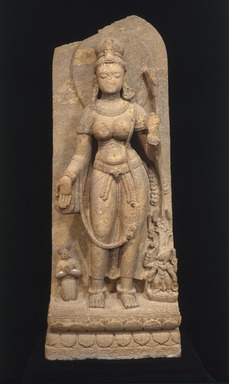
Medium: Khondalite or gneiss
Geograhical Locations:
Dates:8th century
Dimensions: 67 3/8 x 26 x 17 1/2 in., 1109 lb. (171.2 x 66 x 44.5 cm, 503.04kg)
Collections:
Museum Location: Asian Galleries, Southwest, 2nd floor
Exhibitions:
Accession Number: 60.138
Image: 60.138_SL1.jpg,
Catalogue Description: Just under life size female figure, carved in high relief, standing on a low rectangular lotus pedestal, and backed by a thick slab that once curved above her head, but now is partially broken off. Coarse brownish stone now roughened through weathering. At the figure's proper right kneels the very small figure of a worshipper with hands clasped in adoration. At the other side is a four-armed female figure holding symbols. Her right hand is extended downward with palm outward in the varada mudra or gesture of charity. A rosette is impressed on the palm, and there is a lotus behind. The left hand, which once held the stem of a lotus, which grows from behind the little four armed figure and extends upwards in high relief against the slab, is now broken off. The figure stands with the right leg bent, but with the head apparently erect, a pose known as samabhanga. She has her hair done in a high chignon (karanda mukuta) and wears across her forehead a jeweled band. There is a different earring (kundala) in each ear. She also wears a simple necklace (mala), armlets (keyura), bracelets (kankana), a breast band, a tightly clinging skirt that hangs from the waist (dhoti), anklets (nupura) and the sacred thread (yajnopavita), in this case a triple jeweled chain. Behind her head is a nimbus (sirascakra). The surface of the stone is weathered. The top of the back slab, the left hand and the lotus it was holding are broken off. The nose of the main figure is missing and the right breast is damaged. The right earring is also broken. Traces of red paint adhere to the forehead. The back of the slab has been rubbed in some places. The statue has not yet been identified at time of cataloguing. It was evidently one of the saktis, or female counterparts of the male gods in the Hindu pantheon, but which was not yet sure. The Buddhist goddess Tara appears in many forms. As Green Tara, she is associated with the Buddha Amoghasiddi. In this popular form, she is said to rescue her followers from danger. Green Tara is ichnographically represented holding a closed blue lotus. Her right hand is in the gift-bestowing gesture and at her feet are a devotee and Ekajata, a multi-armed attendant. Ekajata holds a noose in her lower left hands and holds her right lower right in varada mudra (palm out, in gesture of wish-granting). her upper hands hold a goad (ankusa) and a bell (ghanta).